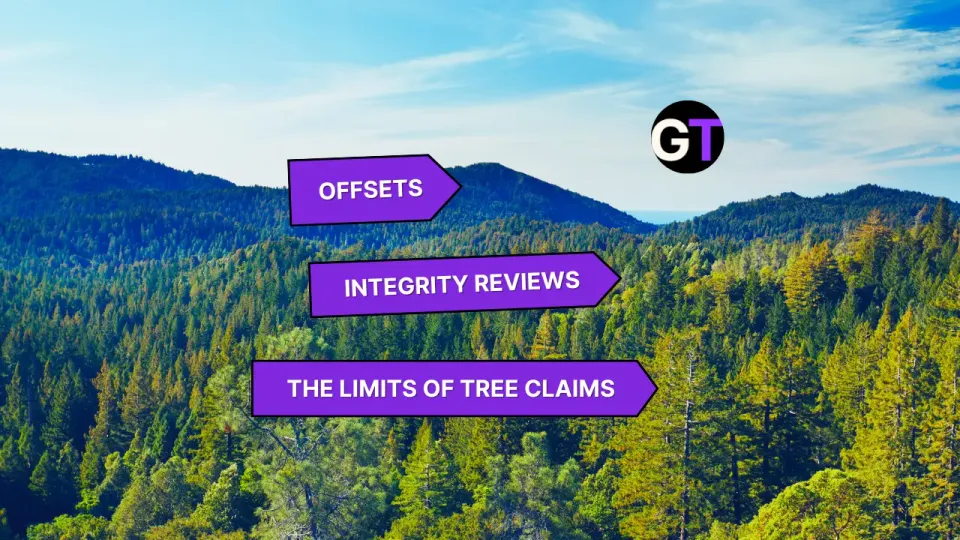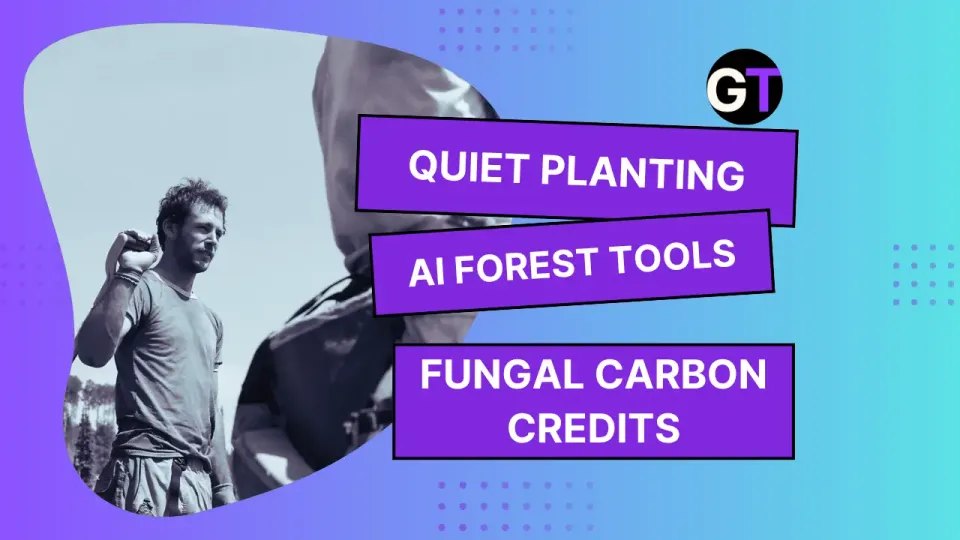Offset Audits, Mossy Comebacks & Digital Forest Maps
From Ethiopia’s tree stats to seed bombs in Cabo, this week’s forest headlines reveal where reforestation meets reality.

Why Auditors Alone Can’t Clean Up Carbon Offsets
The carbon offset market is in hot water—and no, a new fleet of auditors won’t cool it down. In a scathing critique published in Science, Cynthia Giles and Cary Coglianese dismantle the idea that third-party audits can save a system built on fuzzy math and wishful thinking. Drawing from a 95-project review and research across industries, they show how auditors—handpicked and paid by those they’re meant to police—routinely approve credits with shaky climate claims. The kicker? Many of the worst offenders were already certified under this same audit regime. Structural bias, not a few bad actors, is the real climate culprit here.
💬 If auditors aren’t the answer, what’s the next step for credible offsets—radical transparency, tougher rules, or a rethink altogether?
👉👉 Read the full critique from Science
Bangor’s Rainforest Revival: Mosses, Bracken & a £38M Bet on Biodiversity
Bangor University is leading the charge to revive the UK’s rare temperate rainforests, backed by a £38 million initiative from Aviva. In partnership with the Wildlife Trust of South and West Wales, Dr Karina Marsden and the Bangor team are digging into the rainforest’s hidden heroes—mosses, lichens, and epiphytes—to better understand their carbon-absorbing superpowers. They’re testing restoration tactics (planting vs. seeding vs. natural recruitment), tackling invasive species like bracken, and surveying forests of different ages to chart recovery and resilience. Professor John Healey sums it up: they’re laying the scientific groundwork to restore these biodiverse havens at scale and help meet our biodiversity and climate goals.
💬 Will these insights reshape how we value—and revive—what little rainforest the UK has left?
👉👉 Read more via Forestry Journal
Verra Updates Forest Management Methodology (VM0045 v1.2)
Verra has updated its VM0045 methodology, improving the Verified Carbon Standard for improved forest management in the U.S. version. Now aligned with the ICVCM’s Core Carbon Principles, v1.2 adds clearer guidance on identifying de minimis carbon pools, refines uncertainty equations for different plot types, revises monitoring evidence requirements, corrects statistical matching calculations, and specifies required covariates for FIA-based baselines. These tweaks aim to boost accuracy in measuring carbon benefits from practices like enrichment planting, longer rotations, fire management, and reduced harvest. Though currently limited to the contiguous U.S., Verra is exploring global expansion.
💬 Does VM0045 v1.2 strengthen credibility in IFM carbon claims—and are these revisions enough to close integrity gaps?
👉👉 Read the full update from Verra
Mapping Undetected Trees Uncovers Hidden Pan‑Tropical Change
A new Nature Communications study deployed high-resolution (<5 m) satellite imagery and machine learning to reveal that around 17% of pan-tropical tree cover—dubbed Previously Undetected Tree Cover (PUTC)—remained invisible in coarser global datasets. Between 2015 and 2022, the tropics lost about 61 million hectares of tree cover, with nearly two-thirds in forests and the rest in scattered or non-forest areas. The team linked tree gain largely to increased precipitation (~44%), while 56% of losses stemmed from human activity. By capturing isolated trees in agricultural fields, urban zones, and fragmented landscapes, the study reveals crucial missing pieces in carbon-cycle models and climate strategies—especially in regions where low-density trees had previously flown under the radar.
💬 If nearly one-fifth of tropical tree cover has gone unnoticed—and much of it is changing—how should this shift how we manage forests, monitor restoration, and design climate policies targeting carbon sinks?
👉👉 Read the full study in Nature Communications
Ethiopia’s Green Legacy: Ambitious Growth or Number Mirage?
Ethiopia’s Green Legacy Initiative has planted a staggering 40 billion seedlings since 2019—this year aiming for 7.5 billion more, Prime Minister Abiy Ahmed said, calling it “an investment in food sovereignty, climate resilience, and national unity.” Official figures show forest cover rising from 17.2% to 23.6%, and international praise has followed, with South Africa’s Cyril Ramaphosa calling Addis Ababa’s transformation “safe, clean, and vibrant” and the UK Embassy labeling it “unprecedented.” But beneath the optimism, questions loom: how many of those trees survive? Are fruit-bearing or forestry trees counted equally? And is the data independently verifiable?
💬 With forest cover, survival rates, and species mix all vital—how confident can we be that Ethiopia’s tree-planting stats reflect real, lasting change?
👉👉 Read the full story via The Ethiopian Herald and dig into the fact-check at Ground Truth
Los Cabos Considers WWII-Era Aerial Seed Bombing to Restore Estuary
A reforestation mission straight out of a Mad Max-meets-Greenpeace playbook? That’s what’s brewing in San José del Cabo, where the Los Cabos Department of Ecology is weighing a proposal from Earth Army to reforest the Estero Josefino by literally bombing it—with clay-packed seed balls dropped from a repurposed World War II aircraft.
The “seed bombing” approach—already tested in Jalisco—targets hard-to-reach, swampy terrain with native tree seeds (mangrove, willow, hardwood) launched from the sky. Officials are still crunching the logistics: will the bomber’s payload and flight path play nice with the estuary’s delicate ecosystem?
💬 Are seed bombs the future of climate restoration, or just eco-theater with a retro twist?
👉👉 Read the full story via Vallarta Daily
Billion Trees, Bottlenecks & the €150 Carbon Gamble
From Algeria’s $1B reforestation splash to Europe’s carbon credit crunch, this week’s forest finance roundup traces where the money's growing—and where it’s stuck in the mud. Brazil’s trying public land restoration for profit, Canada’s going deep on boreal science, and a global study maps why nature-based climate solutions aren’t delivering. Plus: who's betting big on forests in the U.S., and what does it mean when tree-planting meets private equity?
💬 What does real climate progress look like when every dollar planted expects a return?
👉 Read more our weekly column in Ground Truth
How to Track a Tree (Without Losing the Forest)
CIFOR-ICRAF’s Restoration Monitoring Guide serves up a global, step-by-step playbook for tracking ecosystem restoration. With 21 core indicators and field-ready protocols, the guide helps practitioners design robust, adaptable monitoring plans across forests, farms, wetlands, and more—no PhD required. From carbon stock calculations to community well-being metrics, this isn’t just about measuring trees; it’s about capturing the full story of restoration impact.
💬 How can standardizing what we measure unlock smarter, more accountable restoration—and finally answer the question, “Is this working?”
👉 Read the full guide via CIFOR-ICRAF
Gambian Forest Inventory Goes Digital with Open Foris
The Gambia's forestry team is upgrading from paper to pixels! With FAO’s Open Foris tools—Collect Earth Online, Arena Mobile, and the Arena platform—they’re using satellite imagery, standardized digital field collection, and real-time data validation to build a smarter, faster forest inventory. This leap will provide cleaner, more reliable data for policymaking and climate reporting. u
💬 As The Gambia embraces drones and tablets, can digital systems like Open Foris truly improve the accuracy and speed of national forest inventories?
👉👉 Learn more about the tech behind the move via FAO
Roots, Rocks, and Resistance in Southern China’s Reforested Hills
A new study in Journal of Mountain Science digs deep—literally—into how different reforestation types impact soil structure and stability in southern China’s red soil hills. While reforestation clearly boosts erosion resistance, researchers found that soil cohesion (shear strength) and aggregate stability (crumble factor) respond to different forces: roots and organic carbon, respectively. Translation? Not all trees defend against landslides equally.
💬 As global restoration ramps up, could more targeted reforestation strategies double the benefits for soil and slope stability?
👉👉 Read the full study in Journal of Mountain Science

Edited by Chris Harris

This work is licensed under a
Creative Commons Attribution 4.0 International License.





